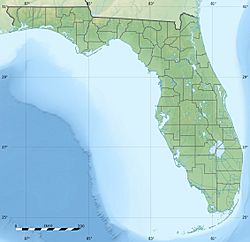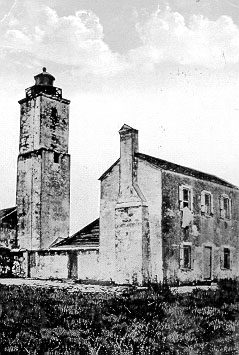Anastasia Island facts for kids

View of Anastasia Island from St. Augustine Lighthouse.
|
|
| Geography | |
|---|---|
| Location | North Atlantic |
| Coordinates | 29°48′15″N 81°16′01″W / 29.80406°N 81.26692°W |
| Administration | |
| State | Florida |
| County | St. Johns |
Anastasia Island is a long, narrow piece of land called a barrier island. It is located off the coast of Florida in the United States, facing the Atlantic Ocean. The island is about 14 miles (23 km) long and usually about 1 mile (1.6 km) wide.
It sits just east of St. Augustine. The Matanzas River separates the island from the mainland. This river is part of the Intracoastal waterway, a system of canals and natural waterways.
Some parts of Anastasia Island are within the city of St. Augustine. Other communities on the island include St. Augustine Beach, Butler Beach, and Crescent Beach.
At the southern end of the island, you'll find Fort Matanzas National Monument. This old Spanish fort was built in the 1740s. It was made to protect St. Augustine from attacks coming from the Matanzas River.
Contents
Island History
The first Europeans might have landed on Anastasia Island in 1513. This was during the journey of Juan Ponce de León. Later, in 1566, Pedro Menéndez de Avilés, who founded St. Augustine, tried to move his settlement to Anastasia Island. This happened after a local Timucuan Indian group revolted. However, this settlement didn't last long, and the colonists soon moved back to the mainland.
The Old Lighthouse
The Spanish built a wooden watchtower on the northern tip of Anastasia Island. Its job was to warn St. Augustine about ships approaching by using signal flags. In 1586, Sir Francis Drake saw this tower. He then came ashore and attacked the city.
Later, the Spanish replaced the wooden tower with one made of coquina. Coquina is a unique rock made from crushed shells. When Florida became part of the United States in 1821, this coquina tower was turned into a lighthouse.
The lighthouse you see today, the St. Augustine Light, was built in 1874. The original coquina lighthouse fell into the sea in 1880. This happened because of coastal erosion, where the ocean slowly wears away the land. The oldest house still standing on Anastasia Island is the lighthouse keeper's house. It was built in 1876 right next to the current lighthouse.
Early Plantations
In 1763, a man named Jesse Fish received a large piece of land on the island. He started a plantation called El Vergel, which means "The Orchard." He planted orange groves there. These oranges became famous, even in London, for being juicy and sweet. By 1776, he was shipping out 65,000 oranges from Florida each year!
The St. Augustine Monster
In 1896, two boys made a strange discovery on the beach. They found a very oddly shaped animal carcass. People called it the St. Augustine Monster. For a long time, many thought it was a giant octopus. Some people who study mysterious creatures, called cryptozoologists, were very interested. However, later studies in 1995 and 2004 showed that it was actually whale blubber.
Modern Development
In the 1920s, a land developer named David Paul Davis, also known as "D. P." or "Doc," started building a new neighborhood. This area, called Davis Shores, is at the north end of Anastasia Island. He filled in the marshy areas across from St. Augustine.
To make it easier to get to his new development, construction began on the Bridge of Lions in 1925. This bridge was finished in 1927. During World War II, the Coast Guard used the lighthouse. Other homes in Davis Shores were used as barracks for soldiers.
Coquina Rock
Underneath the sand on most of Anastasia Island are layers of coquina rock. This rock is made mostly of whole and broken shells from tiny clams. It also sometimes has fossils of sea creatures like shark teeth. This rock layer is known as the Anastasia Formation. It formed during the last Ice Age, between 110,000 and 11,700 years ago.
Coquina was the only natural stone found in the area. The Spanish and later the British used it to build many structures in St. Augustine. This includes the famous Castillo de San Marcos fort. An old well and chimney made of coquina are still visible on Old Beach Road. These are the last remains of the Spanish barracks. These barracks housed the workers who mined the coquina for the fort. The building of the fort took many years, from 1672 to 1695.
Parks
Besides Fort Matanzas National Monument, Anastasia Island is also home to Anastasia State Park. This large park covers about 1,600 acres (6.5 km²). It's a great place to enjoy nature and the outdoors.
Images for kids
-
View of Anastasia Island from St. Augustine Lighthouse.
See also
 In Spanish: Isla Anastasia para niños
In Spanish: Isla Anastasia para niños





